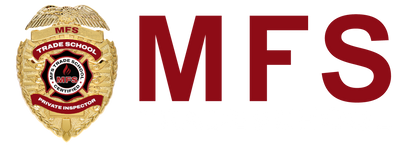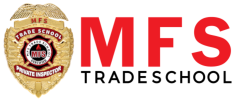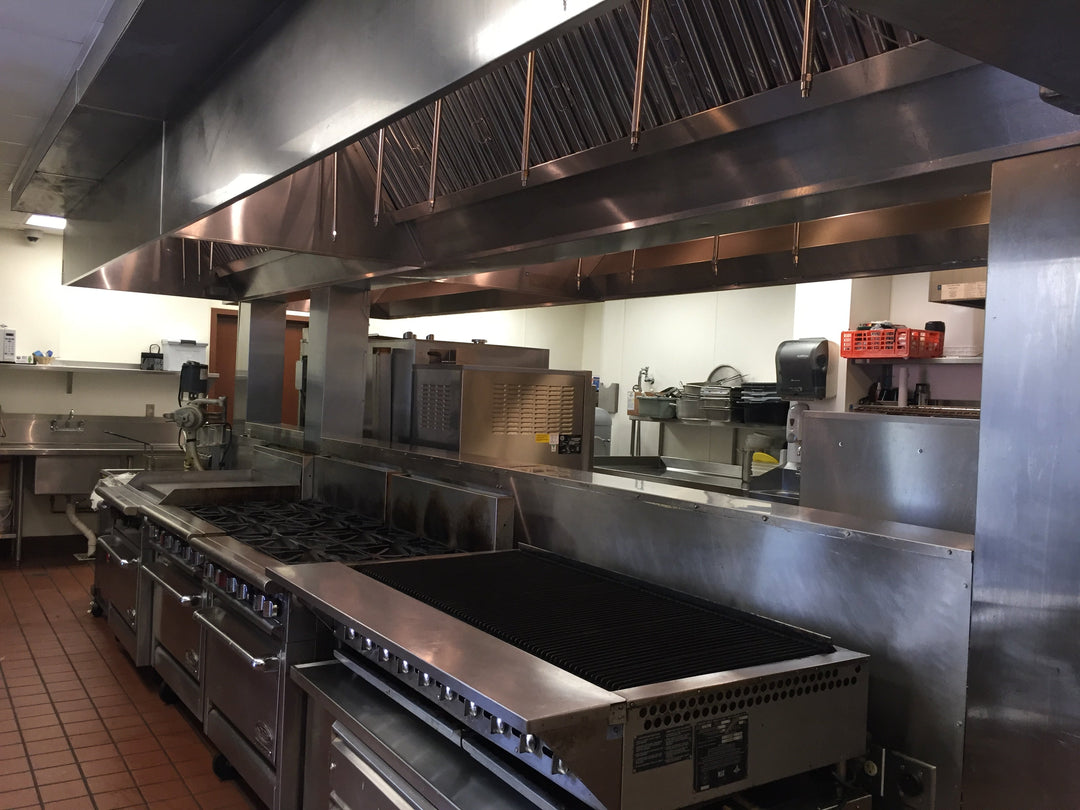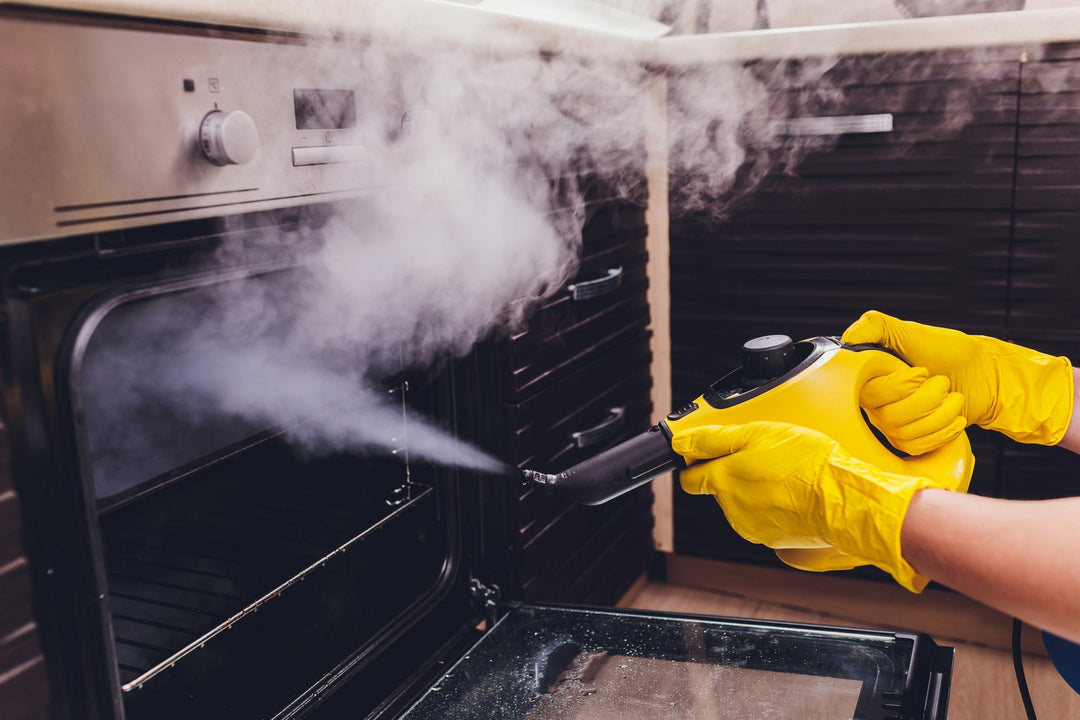Did You Choose the Right Chemicals for Your Commercial Hood Cleaning?
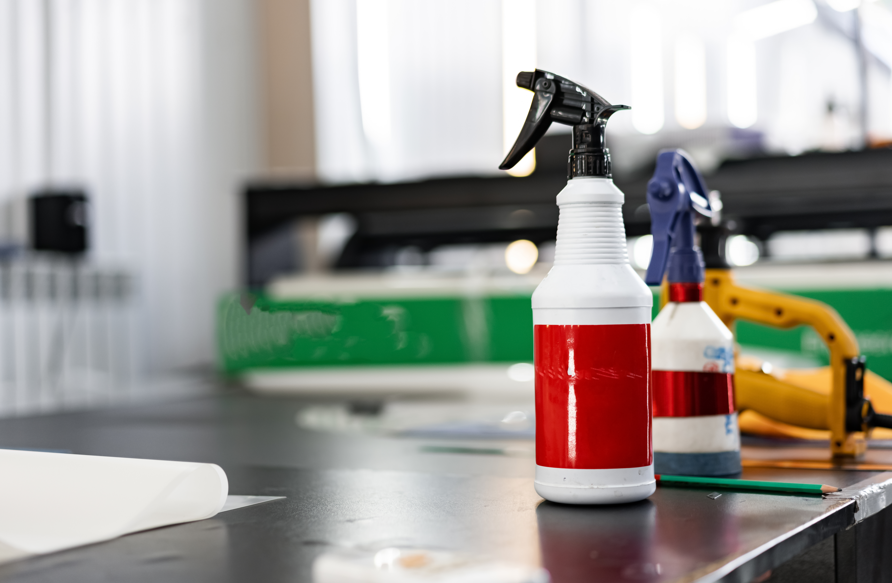
The success of commercial hood cleaning operations hinges on selecting appropriate chemical solutions. Proper chemical selection directly impacts:
-
Grease breakdown efficiency
-
Cleaning time requirements
-
Safety compliance
-
Equipment longevity
-
Operating costs
Kitchen exhaust systems accumulate different types of grease deposits - from light oils to stubborn, baked-on residues. Each type demands specific chemical formulations for effective removal. Using inadequate or incompatible chemicals can lead to incomplete cleaning, damage to hood materials, and potential safety hazards.
The Impact of Chemical Selection
-
Faster grease breakdown
-
Reduced scrubbing requirements
-
Enhanced sanitation results
-
Improved workplace safety
-
Extended equipment life
Our comprehensive guide examines essential factors in selecting commercial hood cleaning chemicals. We analyze various chemical compositions, safety considerations, and cost-effectiveness to help you make informed decisions for your kitchen exhaust cleaning needs.
Whether you manage a small restaurant or oversee multiple commercial kitchen facilities, understanding chemical selection ensures optimal cleaning results. This guide provides practical insights into choosing OSHA-approved solutions, biodegradable options, and pH-neutral cleaners suitable for different hood systems and grease types.
To further enhance your knowledge and skills in this area, consider enrolling in our Kitchen Exhaust Hood Cleaning course at MFS Trade School. This comprehensive training program will equip you with the necessary expertise to tackle any kitchen exhaust cleaning job effectively.
For those who may not have the time for an in-person course, we also offer an online course that provides a flexible learning option. This course is designed to meet the NFPA Code 96 mandates, which require restaurant kitchen exhaust hood systems to be inspected and cleaned by a trained, qualified, and certified person.
As you navigate through these challenges and opportunities in the commercial hood cleaning industry, remember that the right training can make all the difference. If you're interested in learning more about our courses or have specific questions, feel free to reach out through our request info page. Your journey towards becoming a certified professional in kitchen exhaust hood cleaning starts here!
Understanding Different Types of Commercial Hood Cleaning Chemicals
Commercial hood cleaning requires specific chemical formulations designed to break down different types of grease accumulation. Each chemical compound serves a distinct purpose in the cleaning process.
1. Sodium Hydroxide (NaOH)
Sodium hydroxide, commonly known as caustic soda, is a highly effective chemical for cleaning purposes. It is particularly useful in commercial hood cleaning due to its ability to break down grease and oil residues.
Here are some key characteristics and benefits of using sodium hydroxide:
-
Effective against soft grease deposits: Sodium hydroxide works efficiently on soft grease buildup, making it ideal for regular maintenance cleaning.
-
Breaks down fresh oil accumulation: This chemical is capable of breaking down fresh oil deposits, ensuring thorough cleaning of surfaces.
-
Creates a saponification reaction with fats: When sodium hydroxide comes into contact with fats, it initiates a saponification reaction, converting the fats into soap and making them easier to remove.
-
Quick-acting on recent grease buildup: For areas with recent grease accumulation, sodium hydroxide acts quickly, saving time during the cleaning process.
2. Potassium Hydroxide (KOH)
Potassium hydroxide is another powerful alkaline compound used in commercial hood cleaning. It shares similar properties with sodium hydroxide but has some unique advantages.
Here are some key characteristics and benefits of using potassium hydroxide:
-
Specialized for hardened grease removal: Potassium hydroxide is particularly effective in removing hardened grease deposits that may have accumulated over time.
-
Penetrates carbon deposits: This chemical has the ability to penetrate carbon deposits, making it useful for deep cleaning tasks.
-
Dissolves polymerized fats: Potassium hydroxide can dissolve polymerized fats, which are fats that have undergone chemical changes and become more difficult to remove.
-
Effective on long-term accumulation: For areas with long-term grease buildup, potassium hydroxide proves to be an effective solution.
-
Higher temperature tolerance than NaOH: Compared to sodium hydroxide, potassium hydroxide has a higher tolerance for elevated temperatures, making it suitable for certain cleaning applications.
3. Alkaline-Based Industrial Degreasers
Alkaline-based industrial degreasers are commercially available cleaners that contain a combination of alkaline ingredients. These products are designed to provide powerful cleaning action against tough grease and grime.
Here are two examples of popular alkaline-based industrial degreasers:
Simple Green Industrial Cleaner
Simple Green Industrial Cleaner is a versatile cleaner that can be used on various surfaces. Its pH-balanced formula makes it safe for use in different environments.
Key features of Simple Green Industrial Cleaner include:
-
Biodegradable composition
-
Non-corrosive properties
-
Suitable for daily cleaning tasks
ZEP Heavy-Duty Degreaser
ZEP Heavy-Duty Degreaser is an industrial-strength formulation specifically designed for heavy-duty cleaning applications. It contains high concentration ratios of active ingredients to ensure effective grease removal.
Key features of ZEP Heavy-Duty Degreaser include:
-
Fast-acting grease penetration
-
Enhanced soil lifting capabilities
-
Professional-grade results
Chemical Concentration Guidelines
When using chemicals for commercial hood cleaning, it's important to follow proper dilution ratios based on the level of buildup being addressed. Here are some general guidelines:
-
Light cleaning: 1:10 dilution ratio
-
Medium buildup: 1:5 dilution ratio
-
Heavy deposits: 1:3 dilution ratio
-
Extreme cases: Direct application
These ratios indicate the proportion of cleaner to water that should be used depending on the severity of the grease accumulation.
Professional-Grade Products
Professional-grade products combine multiple active ingredients to maximize cleaning efficiency. These formulations often include both sodium and potassium hydroxide, creating a powerful synergistic effect for comprehensive grease removal.
The selection of specific chemicals depends on factors such as:
-
Grease type
-
Accumulation level
-
Cleaning frequency
By understanding these factors and choosing appropriate chemicals accordingly, commercial kitchens can achieve optimal results in their hood cleaning efforts.
Importance of Cooking Oil Filtration
An important aspect of managing grease accumulation in commercial kitchens is the use of proper cooking oil filtration, which can greatly enhance the lifespan of cooking oil and overall kitchen efficiency.
Implementing effective filtration systems not only reduces the amount of waste generated but also improves food quality by ensuring consistent frying results. This proactive approach towards oil management complements regular hood cleaning practices and contributes to a cleaner working environment.
Fire Code Compliance
Fire code compliance remains essential when selecting cleaning chemicals. All products must meet local regulations and safety standards for commercial kitchen applications.
Regular testing ensures continued effectiveness while maintaining safety protocols. Additionally, implementing seasonal maintenance tips for kitchen exhaust systems can significantly improve their performance and longevity.
High-Quality Industrial Equipment
For those heavy-duty cleaning tasks where conventional methods may fall short, using high-quality industrial equipment becomes necessary. One such tool that can greatly assist in tackling tough grease and grime effectively is a 100ft pressure washing hose.
This versatile hose allows users to connect their pressure washer units seamlessly while providing extended reach capabilities across various surfaces. With its robust construction and compatibility with different nozzle attachments, this accessory proves invaluable during intensive cleanup operations involving stubborn dirt or oily residues.
By combining appropriate chemical solutions with advanced machinery like pressure washers equipped with specialized nozzles (e.g., turbo or surface cleaners), professionals gain access to powerful techniques capable of delivering exceptional results consistently across diverse environments—be it restaurants kitchens or food processing facilities—where hygiene standards play a pivotal role in ensuring safety compliance amidst rigorous inspections conducted periodically by regulatory authorities governing such establishments globally!
Factors Influencing Chemical Selection for Hood Cleaning
The Sinner Circle concept plays a crucial role in determining the effectiveness of hood cleaning chemicals. This scientific approach identifies four key elements:
-
Chemical action (15%)
-
Temperature (25%)
-
Mechanical force (25%)
-
Time (35%)
Understanding these elements helps select appropriate cleaning agents that work harmoniously with your cleaning methods and equipment.
Grease Buildup Types and Chemical Requirements
Different grease formations demand specific chemical solutions:
-
Soft, Fresh Grease: Requires mild alkaline degreasers
-
Carbonized Grease: Needs strong caustic solutions
-
Animal Fat Deposits: Benefits from high-temperature resistant chemicals
-
Polymerized Oils: Demands specialized solvents
For effective removal of these types of grease, professional-grade products like hood degreasers are essential.
Hood System Material Compatibility
The hood system's construction material dictates chemical selection:
-
Stainless Steel: Compatible with most commercial cleaners
-
Galvanized Metal: Requires non-acidic solutions
-
Aluminum: Needs pH-neutral or specially formulated cleaners
-
Copper: Demands non-abrasive, gentle chemical formulations
Chemical Application Considerations
Proper chemical selection also depends on:
-
Application method (spray, foam, or manual)
-
Required dwell time
-
Ventilation conditions
-
Local temperature variations
-
Water hardness levels
NFPA 96 Compliance
Selected chemicals must meet NFPA 96 standards for:
-
Flash point requirements
-
VOC content
-
Safety documentation
-
Storage guidelines
The interaction between cleaning chemicals and hood materials can impact both cleaning effectiveness and system longevity. Professional-grade foaming degreasers offer superior adherence to vertical surfaces, maximizing contact time with stubborn grease deposits. Equipment-friendly solutions prevent damage while maintaining optimal cleaning power.
However, it's important to note that hood cleaning is not just about removing grease; it's also a critical part of ensuring fire safety in commercial kitchens. Implementing effective hood cleaning strategies can significantly reduce fire hazards and promote a safe kitchen environment.
If you're considering starting a hood cleaning business, understanding the costs, training, and certification requirements is crucial. Moreover, seeking mentorship can greatly accelerate your business growth by providing valuable insights and guidance from industry experts.
The Advantages of Using Professional-Grade Degreasers in Commercial Hood Cleaning
Professional-grade degreasers combining sodium hydroxide and potassium hydroxide deliver superior cleaning performance in commercial kitchen environments. These advanced formulations create a powerful synergistic effect:
-
Enhanced Grease Dissolution: The sodium-potassium hydroxide blend attacks both soft and hardened grease deposits simultaneously
-
Reduced Cleaning Time: Professional formulas work faster than standard cleaners, minimizing kitchen downtime
-
Extended Equipment Life: Proper removal of grease buildup prevents corrosion and system deterioration
-
Improved Safety Compliance: High-performance degreasers help maintain NFPA 96 standards for fire prevention
-
Cost-Effective Solution: Despite higher initial costs, professional degreasers require less product and labor
Professional degreasing formulas also incorporate specialized surfactants and penetrating agents that enhance their effectiveness:
-
Deep Penetration: Advanced chemistry allows cleaners to reach hidden grease deposits
-
Residue-Free Results: Professional products rinse clean without leaving chemical traces
-
Temperature Stability: Maintains effectiveness across varying hood system temperatures
-
pH-Optimized: Balanced formulations protect metal surfaces while removing grease
These high-performance products often include built-in indicators that change color when the solution needs replacement, ensuring consistent cleaning results. Professional-grade degreasers also undergo rigorous testing to meet food service industry standards and local health department requirements.
Restaurant operators who invest in professional degreasing solutions benefit from documented compliance with inspection requirements and reduced risk of fire hazards. These specialized formulas provide comprehensive protection against the full spectrum of kitchen grease challenges.
Safety Considerations When Choosing Chemicals for Hood Cleaning
Safe handling practices are critical when working with commercial hood cleaning chemicals. Caustic soda and other corrosive agents require strict safety protocols to prevent accidents and injuries during the cleaning process.
Essential Safety Equipment:
-
Face shields or safety goggles
-
Protective clothing and boots
-
Respiratory protection
-
Emergency eyewash stations are nearby
Chemical Handling Guidelines:
-
Store chemicals in properly labeled containers
-
Keep Safety Data Sheets (SDS) readily accessible
-
Maintain proper ventilation during use
-
Never mix different cleaning agents
-
Use only approved grease cleaning agents
Surface-safe grease removers and green-certified kitchen degreasers offer safer alternatives for specific applications. These products balance effective grease removal with reduced risk to operators and equipment.
Training Requirements:
-
Chemical hazard recognition
-
Proper dilution procedures
-
Emergency response protocols
-
Equipment maintenance standards
Hood cleaning foaming agents require special attention due to their high alkalinity levels. When removing grease from ductwork, industrial food-grade degreasers must be applied using appropriate pressure and temperature controls to prevent chemical splash-back.
Restaurant equipment cleaning chemicals vary in strength and application methods. MFS chemical knowledge training emphasizes the importance of selecting cleaning agents for duct systems based on both effectiveness and safety parameters. The proper handling of hood cleaning chemicals directly impacts worker safety and equipment longevity.
To ensure safe and effective hood cleaning, investing in the right equipment is crucial. Our Gold Package Kitchen Exhaust Hood Cleaning includes all major equipment needed to start your business, such as pressure washers, hoses, foam sprayers, chemicals, safety gear, and more.
Balancing Effectiveness, Safety, and Cost in Chemical Selection for Hood Cleaning
Selecting the right cleaning chemicals requires careful consideration of three critical factors: effectiveness, safety, and cost. Each factor plays a vital role in maintaining efficient kitchen operations.
Effectiveness vs. Grease Types
-
Light grease deposits respond well to standard degreasers
-
Heavy carbonized grease requires stronger alkaline solutions
-
NSF-certified kitchen cleaning chemicals guarantee food-safety standards
-
Non-flammable kitchen degreasers suit high-temperature environments
Cost Analysis Breakdown
-
Initial purchase price of chemicals
-
Dilution ratios affecting usage quantities
-
Labor hours required for the application
-
Equipment maintenance costs
-
Frequency of cleaning cycles
Cost-Effective Solutions
-
Bulk purchasing from certified chemical suppliers
-
Training staff in proper chemical application methods
-
Implementing preventive maintenance schedules
-
Using concentrated formulas with correct dilution
Safety-Cost Balance
-
Investment in proper PPE equipment
-
Staff training on chemical handling procedures
-
Storage facility requirements
-
Emergency response protocols
-
Ventilation system requirements
Maximizing ROI
-
Regular assessment of cleaning effectiveness
-
Documentation of chemical performance
-
Monitoring usage rates
-
Tracking labor efficiency
-
Equipment longevity evaluation
Chemical Selection Strategy
-
Test different products on small areas
-
Compare performance metrics
-
Evaluate staff feedback
-
Monitor cleaning time requirements
-
Assess residue levels
The selection of heavy-duty ventilation system cleaners must align with specific kitchen requirements. Grease emulsifiers for kitchens vary in strength and composition, affecting both performance and cost. Professional kitchen operators often find value in specialized degreasers for aluminum hood filters, which protect equipment while maintaining cleaning standards.
A systematic approach to chemical selection helps balance these competing factors. Regular evaluation of cleaning processes, chemical effectiveness, and cost metrics ensures optimal resource allocation while maintaining safety standards. For those looking to enhance their operations further, transforming a hood cleaning business within a year is an achievable goal with the right strategies in place.
Ensuring Compatibility: A Key Step in Choosing Chemicals for Hood Cleaning
Chemical compatibility is crucial for keeping your kitchen exhaust system in good shape. Using the wrong chemicals together can result in:
-
Equipment damage
-
Ineffective cleaning
-
Safety risks
-
Higher maintenance expenses
Key Compatibility Considerations:
1. Surface Material Interaction
Different materials require specific types of cleaners:
-
Stainless steel requires non-abrasive cleaners
-
Aluminum components need pH-balanced solutions
-
Galvanized surfaces demand specific chemical formulations
2. Equipment Specifications
Make sure your cleaning equipment is compatible with the chemicals you choose:
-
Check if your pressure washer can handle the solution
-
Ensure that the steam cleaning methods are suitable for the chemical
-
Consider manual application techniques and their requirements
3. Ventilation System Components
Don't forget about the different parts of your ventilation system:
-
Verify if the filter material can withstand the chemical
-
Protect the coating of your ductwork with appropriate solutions
-
Safeguard the fan blades by using compatible products
Chemical Application Methods
The way you apply chemicals also matters:
-
For foam-based applications, use chemicals with the right thickness
-
Spray systems need solutions that won't block nozzles
-
Manual cleaning requires products with suitable contact times
System-Specific Requirements
Your hood system has its own characteristics that affect chemical selection:
-
Is your ductwork vertical or horizontal?
-
Do you have fire suppression systems in place?
-
What is the age and condition of your equipment?
-
Are there any local temperature variations to consider?
Proper chemical compatibility goes beyond just being able to clean - it ensures that your kitchen exhaust system lasts longer and performs at its best. Regularly checking how chemicals interact with your specific equipment protects your investment and keeps safety standards intact.
Additionally, implementing advanced virus disinfection techniques for commercial kitchens is becoming increasingly important. These protocols not only help in maintaining cleanliness but also protect customers from foodborne illnesses and viral outbreaks, as highlighted in this article on advanced virus disinfection methods.
Moreover, regular equipment maintenance is crucial for cleaning businesses. It boosts efficiency, reduces downtime, and saves on costly repairs, which is discussed further in our blog post about the top reasons equipment maintenance matters.
If you're starting a hood cleaning business, consider our Silver Package Exhaust Hood Cleaning, which covers all necessities for a successful start-up.
For restaurant owners, maintaining cleanliness is not just about aesthetics but also about adhering to health standards. Our article on essential restaurant cleanliness tips from health inspectors provides valuable insights into this subject.
If you have any questions or need further information regarding training and certification programs for the restaurant cleaning and maintenance industry, feel free to contact us.
Conclusion
Choosing the right chemical agents for cleaning kitchen exhaust systems is crucial for upholding food safety and fire prevention standards. The effectiveness of grease removal, system longevity, and workplace safety all depend on the proper selection of cleaning products.
When selecting professional-grade degreasers, it's important to carefully consider the following factors:
-
Hood material compatibility
-
Type of grease buildup
-
Safety requirements
-
Environmental impact
-
Cost-effectiveness
By doing so, you can achieve superior results in maintaining commercial kitchens.
However, cleaning alone is not enough. Regular kitchen exhaust cleaning is essential for improving health ratings and ensuring compliance with health department standards.
In addition, it is crucial to prioritize safety from pathogens during these times. MFS (Maintenance Facility Services) offers specialized virus disinfecting services that provide thorough and efficient solutions to protect your space.
Need expert guidance on chemical selection?
MFS also offers specialized consultation and access to industry-leading hood cleaning products. Our team's extensive experience in commercial kitchen maintenance allows us to recommend the most effective solutions tailored to your specific needs.
-
Receive personalized product recommendations
-
Access professional-grade cleaning solutions
-
Learn proper chemical handling techniques
-
Optimize your hood cleaning routine
With our versatile MFS Electrostatic Misting Fogger, you can easily disinfect large areas in no time.
Trust MFS to help you maintain a cleaner, safer kitchen environment with the right chemical solutions for your commercial hood cleaning needs.
FAQs (Frequently Asked Questions)
What are the key chemicals used in commercial hood cleaning, and how do they work?
Commercial hood cleaning utilizes chemicals such as sodium hydroxide and potassium hydroxide, which are alkaline-based degreasers effective at breaking down soft and hard grease buildup, respectively. Industrial-strength cleaners like Simple Green Industrial Cleaner and ZEP Heavy-Duty Degreaser provide powerful grease-cutting action suitable for kitchen exhaust systems.
How does the Sinner Circle influence chemical selection for hood cleaning?
The Sinner Circle concept emphasizes the balance of four factors: chemical action, temperature, mechanical action, and time. Understanding this helps in selecting chemicals that effectively remove different types of grease buildup while considering the material compatibility of the hood system and ensuring safe application methods.
What advantages do professional-grade degreasers offer for commercial kitchen hood cleaning?
Professional-grade degreasers often combine sodium hydroxide and potassium hydroxide to deliver high-performance grease removal. They are formulated to be non-toxic, fire-safe, and compliant with kitchen inspection standards, providing advanced chemistry that enhances sanitation while protecting equipment and personnel.
What safety precautions should be taken when using hood cleaning chemicals?
Due to the corrosive nature of chemicals like caustic soda (sodium hydroxide), it is crucial to use appropriate protective equipment such as gloves and eye protection. Handling should follow manufacturer guidelines to avoid toxic fumes, surface damage, or injury. Using green-certified or NSF-certified degreasers can also improve safety in commercial kitchens.
How can one balance effectiveness, safety, and cost when selecting chemicals for hood cleaning?
Balancing these factors involves choosing chemicals that effectively target specific grease types while ensuring they are safe for both users and kitchen equipment. Considering product certifications like NSF approval, evaluating residue impact on foodservice safety, and assessing cost-effectiveness through supplier comparisons helps optimize chemical selection.
Why is chemical compatibility important in commercial hood cleaning?
Ensuring compatibility between cleaning chemicals, methods, and hood equipment is vital to achieve optimal results without causing corrosion or damage. Selecting low-odor, anti-corrosion degreasers that are suitable for ventilation systems prevents equipment degradation and supports fire prevention measures during kitchen exhaust sanitation.
